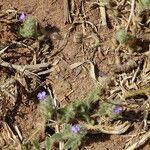Creeping or decumbent herb, to 70 cm long and 10-30 cm tall; often rooting at node. Stem slender, prostrate or ascending, younger stem moderately pubescent, older stem glabrate. Petiole 2-10 mm long, moderately pubescent; blade ovate, 4-7 x 2-3.5 cm, acute at apex, attenuate and decurrent on petiole at base, glabrous or nearly so and glandular punctate on upper surface, sparsely to moderately pubescent and glandular punctate on lower surface, margin entire or undulate; leaves subtending inflorescence reduced and intergrading with bracts, 8-22 x 4-12 mm, more densely pubescent than cauline leaves. Inflorescence terminating main and lateral branches, spikes quadrangular, 2.5-5 cm long, solitary or arranged in terminal fascicles of 1-3 spikes, central spike sessile or pedunculate, lateral spikes with peduncles of 20-25(-50) mm long, rachis densely sericeous; bracts ovate, 4-6 x 2-4 mm, imbricate, apically acute, margin entire, abaxial surface pubescent with long, filiform trichomes mixed with shorter glandular ones. Flowers subsessile; calyx usually with dense, long, fine, eglandular trichomes at base, posterior lobe ovate, 3-3.6 x 1.2-1.5 mm, 5-8-veined, lateral lobes lanceolate, 3-4 x 0.5-0.8 mm, 1-3-veined, anterior lobe lanceolate, usually apically notched, rarely entire or twice notched, 2.5-3.6 x 0.5-1.3 mm, ca. 8-veined; corolla white, 7 mm long, glabrous or minutely puberulous, tube 3-5 mm long, limb ca. 2 mm wide, upper lobes, slightly shorter than lower ones; filaments 0.3-0.5 mm long, anther thecae parallel in bud, divergent in flower, 0.4 mm long, apically with a small, hook-like mucro; ovary 0.9-1 mm long, style ca. 0.8 mm long, glabrous. Capsule 4-4.8 x 1.5 mm, glabrous, seeds usually ca. 28.
More
Herbs 10-20 cm tall, annual, creeping, sprawling, prostrate, or decumbent. Stems subterete, villous, often rooting at nodes. Petiole 0.2-3(-4) cm, villous; leaf blade elliptic to ovate, 1-2.2 × 0.4-1.2 cm but basal ones sometimes 6-12 × 3.5-5 cm, both surfaces villous, secondary veins 3-7 on each side of midvein, base cuneate, margin entire, apex acute. Spikes 1.5-4 cm; bracts elliptic, 6-7.5 × 3-4 mm, 5-7-veined. Calyx abaxial lobe ca. 2 × 0.6 mm, apex 2-lobed; adaxial lobe ca. 3 × 1 mm; lateral lobes ca. 2 × 0.5 mm. Corolla bluish purple or white, externally glabrous; tube cylindric for ca. 1.5 mm, contracted near midpoint then expanded into throat; lower lip ca. 2.3 mm; upper lip ca. 2 mm. Stamens inserted at base of throat; filaments ca. 0.5 mm, glabrous. Ovary glabrous; ovules 4-8 per locule. Capsule ca. 5 × 2 mm, 8-16-seeded. Seeds broadly ellipsoid, granulate. Fl. Oct-Mar, fr. Mar-May. 2n = 34 + ß, 36.
A herb which grows from seed each year. It grows 10 cm high and spreads 50-100 cm wide. The young growth is densely hairy. The stems lie along the ground. They form roots at the nodes. The leaves are 6 cm long by 3.5 cm wide. The lowest leaves are the largest. They are greyish-green with a pointed tip. The flower spikes are 1-6 cm long by 1 cm wide. They can be in the axils of leaves or at the ends of branches. The flowers are 0.5 cm long. They are white. The capsules are 0.5 cm long.
Erect spikes of small pink or purple flowers.
Softly pubescent prostrate branching herb


